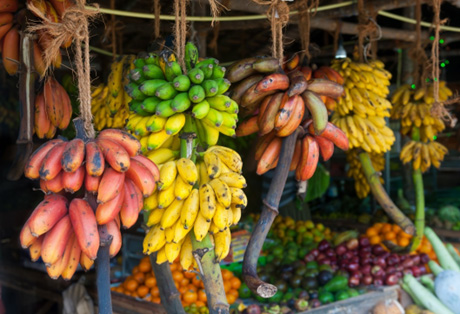I’m Chiquita Banana and I’m here to say
I am the top banana in the world today.
Chiquita is a very different banana today than when she first appeared in the 1940s commercial with Bobby Soxers and a gooey banana split. Since then we’ve been flooded with banana bread, chocolate-covered frozen bananas, and banana cream pie.
What could be bad?
These days, Chiquita is a health food, a baby food, and the main ingredient in your smoothie. According to Business Mirror, bananas are the third healthiest fruit behind avocados and apples. Guinness World Records agrees, reporting that bananas are the most popular fruit in the world.
There’s a lot more to the story than whipped cream and chocolate syrup. Let’s look at the first banana.
It wasn’t a pretty sight. Some scientists believe that bananas were discovered 10,000 years ago in the Malaya Peninsula, Indonesia. Traders and travelers spread the tasty fruit around the world. They were called “banan” in Arabic and “Plantain” in Spanish.
Wild bananas were filled were filled with large, dark seeds that made them hard to eat. Over thousands of years, humans, animals, and nature selected and cultivated seedless, creamy bananas until there were hundreds of different tasty varieties.
Eventually the Gros Michel emerged – a sweet, creamy fruit, easy to grow, seedless, and a thick skin ideal for transport. It became the world’s most popular banana. As a result, farmers phased out the other types, growing only Gros Michels. Every Gros Michel was a clone, genetically identical to all the others. Behind the banana leaves lingered danger: a threat to one Gros Michel was a threat to all.
Nature thrives on genetic diversity. That’s why we don’t marry our parents or siblings. Lack of diversity creates problems. In the early 1900s a deadly soil fungus called Panama 1 attacked. It spread around the world because Gros Michel bananas didn’t have any resistance.
The world’s crop of bananas was almost destroyed. Growers scrambled for a new variety and discovered the Cavendish. Unfortunately, like a classroom bully, they didn’t learn their lesson. Cavendish become the top cherry because it’s resistant to Panama 1.
No one bothered to build in diversity and today we all eat Cavendish.
Climate change nurtured a new virus – Panama 4. It’s spreading like wildfire, nurtured by the higher temperatures and stronger tropical storms caused by global warming. Today’s favorite banana, Cavendish, is now threatened.
Diversity improves the ability of crops to adapt to environmental changes and new pathogens. Bananas are not the only crop at risk. Critical crops like wheat, corn, and rice have little or no genetic diversity because it’s easier (and more profitable) to grow that way. Now, because of climate change, these crops risk the same history as bananas.
While the world increasingly suffers from food insecurity, failed crops, and lack of agricultural diversity.
Don’t go bananas. The next time you drink from a one-use plastic bottle, ignore the warnings from climate scientists, and vote for climate change deniers, think again.







Well written. Here, here!
Excellent article! Your work is always entertaining and informative. I enjoy all of your writing so very much!
Great article! I appreciate the clear and insightful perspective you’ve shared. It’s fascinating to see how this topic is developing. For those interested in diving deeper, I found an excellent resource that expands on these ideas: check it out here. Looking forward to hearing others’ thoughts and continuing the discussion!